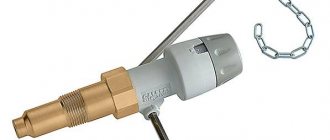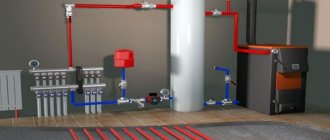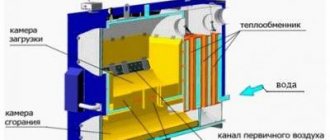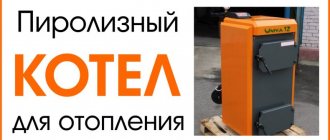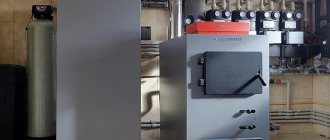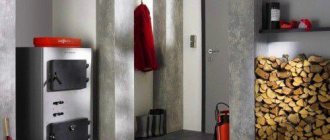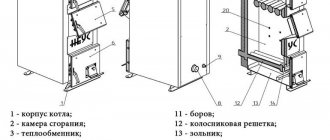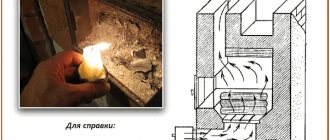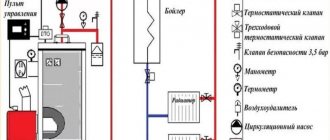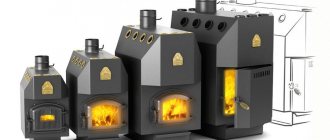Home / Solid fuel boilers
Back
Published: 05/25/2019
Reading time: 2 min
0
6324
In the recent past, the rate of fuel combustion in solid fuel heating units could only be adjusted manually. For this purpose, there was a ash door, by opening or closing which the air flow to the firebox increased or decreased.
Today, an automatic device called a draft regulator for a solid fuel boiler is successfully used for this purpose. To set the required temperature. When using it, it is enough to determine the required coolant temperature. The presented characteristics will help demonstrate the capabilities of a useful invention for the home.
- 1 Why do we need draft regulators?
- 2 Operating principle
- 3 Types of regulators, and which ones are better
- 4 How to install and configure the regulator
Installing a draft regulator on a solid fuel boiler and its further adjustment
Before installing the regulator on the boiler, use pipeline fittings to cut it off from the pipeline and drain the coolant from the boiler. If it is not possible to shut off the boiler (the fittings were not installed during installation), all the coolant is drained from the system.
Having unscrewed the plug from the coupling (sleeve), we manually tighten the regulator to check the thread size. If everything is normal and it is clear which layer of FUM tape to wrap on the thread of the device, apply a sealant to the thread and tightly, but without fanaticism, screw it into the sleeve with a wrench. If the sleeve is on the side of the boiler, then the arrow on the regulator handle points upward when screwed in all the way. When mounted from above, the slot of the device scale must be tightened to the front of the boiler.
A lever is inserted into the regulator seat so that the chain inserted into its hole hangs vertically above the ash pan door and does not interfere with operation when tensioned. After broaching, all connections are secured with a heat-resistant compound. After installation, the coolant level in the heating system is restored and the pipeline fittings are opened, and the firebox is loaded with fuel.
The installed regulator must be configured; for this, the following sequence of actions is carried out:
- The ash door is raised completely and the fuel is ignited.
- The latch on the handle of the device is unscrewed.
- The coolant temperature of the lower level of the range is set to 60° C.
- The chain is attached to the lever.
- After reaching the set temperature, the blower door is lowered, leaving a gap of about 2 mm.
- The second end of the chain is fixed on the handle of the ash pan so that the slack is no more than 1 mm.
- The screw on the thermostat knob is tightened.
Life advice. Before actively operating a boiler with a mechanical thermostat, it is necessary to patiently train the heating system at different temperatures within the control range, and, if necessary, adjust the length of the chain to reduce the error to 5%.
Combustion of solid fuel and heating of the coolant to a given temperature is an inert process, not fast. Therefore, the reaction to changing the setting on the thermostat knob will be delayed and it would be right not to rush things.
It is advisable to calibrate the device more often, especially at the beginning of the heating system operation. A change in the type of solid fuel and supplier should also first lead to a regular check of the compliance of the set temperature on the regulator handle and the actual temperature on the boiler thermometer. If necessary, configure the device by adjusting the size of the chain.
Conclusion. This method of obtaining stable operation of a solid fuel boiler is not as accurate as those associated with fans, smoke exhausters and a computer, but for the money it is reliable, autonomous and, in many cases, a benefit for a long time.
Connection diagrams
All methods of connecting a thermostat to a heating system are divided into three connection options:
- Directly to the boiler.
- To the circulation pump.
- On the pipe supplying coolant to the radiator.
The first two schemes eliminate the deterioration in the throughput of the heating pipeline. No additional locks are placed in it, and the hydraulic resistance of the entire system does not change. The thermostat here only controls the operation of the pump or boiler; it “does not come into contact” with water.
When installing a thermostat on a battery or a common pipe with several radiators, the hydraulic resistance, on the contrary, increases. Even when fully open, the thermostat valve slightly slows down the flow of coolant.
Ideally, the boiler piping project should be carried out immediately, taking into account all thermostatic and other devices.
If the water heating system in the house is made according to a single-pipe scheme, then it is better to immediately abandon the third option. When the temperature sensor is triggered, the valve will immediately shut off the entire radiator line in several rooms, and then you can immediately forget about comfort in rooms far from the boiler.
The thermostat should be connected to the radiator input via a bypass. So, when triggered, it will redirect the coolant flow bypassing the battery. In this case, the water will return uncooled back to the boiler. The latter will stop heating it, thereby reducing the consumption of gas fuel or electricity.
The temperature sensor must be mounted:
- in a place where there is no direct sunlight;
- away from cold bridges, drafts and rising heat flows from radiators;
- so that it is not covered by decorative screens or curtains;
- at a height from the floor within 1.2–1.5 meters.
If the sensor is installed incorrectly, the thermostat will produce false signals. This can lead to overheating not only of the air in the room, but also of the coolant in the system. And in the second case, it won’t be long before there are problems with the boiler.
What is a draft regulator for solid fuel boilers?
The draft regulator is an automatic device designed to control combustion and regulate temperature. The uniqueness of this device is that it is completely energy independent, and therefore, in the absence of electricity, the boiler will be able to continue operating and the functioning of the heating system will be stable. Draft regulators are installed on most simple-type solid fuel boilers. Modern boilers use more complex and multifunctional mechanisms. But these remain popular due to several advantages:
- Simplicity in design and operation;
- Reliability;
- Possibility of making it yourself;
- High accuracy;
- Low cost and easy to repair.
Quite banal, but very important advantages of a draft regulator for solid fuel boilers. They are bought for both old and modern, expensive boilers
Traction controls are important in operation, but how does a simple design take on so much?
Operating principle of a draft regulator for a solid fuel boiler
The regulator itself can be installed in different places on the boiler. As a rule, the manufacturer himself shows where it is necessary to connect the draft regulator for the boiler, or where the water jacket fits. The traction regulator needs to be in contact with the coolant so that the special gas (sometimes liquid) located in the sleeve expands during the heating process. After this, the actuator is assigned the task of lowering the lever, which already reduces the draft in the solid fuel boiler.
The principle of operation is very simple, which is why these levers can be made with your own hands. With the correct design of a homemade draft regulator, it is no different and can also serve usefully.
How to set up a draft regulator for a solid fuel boiler?
- Before setting up, you must disconnect the circuit from the air damper
- Loosen the handle lock as much as possible
- Adjust the scale according to the current situation and set the required temperature level
- Light the boiler and reach the set temperature (see point 4)
- When this temperature is reached, place the chain on the choke handle. When set correctly, the chain should be taut.
After this, you can enjoy the operation of the traction regulator and have peace of mind about heating when you are away from home. These designs are really useful and easy to use; they save the situation when there is a power outage, which often happens in our country. The operating principle, based on mechanics and the laws of physics, is the most reliable way to regulate the boiler.
Types of control devices
Thermostats for heating boilers with the option of temperature control are divided into several types:
- mechanical models with one function;
- programmable models with a large range of auxiliary settings.
Wireless models
Also, similar designs are wireless and wired. Thermostats are installed in the selected location, a temperature sensor is connected and connected to the control device.
Design diagram of the control device
Note! Thermostats must be provided with constant air access to prevent overheating. It is also not recommended to install electrical appliances nearby.
Selecting a room programmable device
The option of an electronic temperature sensor for a heating boiler helps you select the appropriate temperature mode and change it at your discretion. The room thermostat sets the set values every day. Some setpoint values can be programmed, for example when day turns to night.
Such controllers have additional options. For example, a function that allows you to stop heating for a while and then resume it. You can also change the programmable temperatures for the duration of the configured periods. Another useful option is the ability to change the heating intensity.
Room type regulator
Thermostat as a central element
The central thermostat for the heating boiler (temperature regulator) is located at a certain distance from the heating unit and allows you to turn off and turn on equipment throughout the house.
Installation diagram of thermostats in the heating system
Thermostat for heating radiator. What task does this device perform and what is its advantage? What is the operating principle and correct installation? Prices also matter. More details in a special publication.
Models from previous years are connected directly to the heating unit by wires, while more modern designs are distinguished by remote control. The latest devices are mounted in dual-circuit units Beretta, Ferroli and AOGV. Room control mechanisms for boilers of the Protherm and Gsm brands are popular. They differ in their dilatometric mechanism.
Principle of operation
The draft is adjusted by changing the degree of rarefaction of the gases in the pipe. For this purpose, a stabilizer is built between the chimney pipe from the firebox and the entrance to the chimney. It can work in manual or automatic mode.
The chimney draft regulator is a damper (valve) built into a separate housing. When the draft increases, the valve opens slightly and releases a portion of air from the room. The gas flow cools, the lifting force from the thermal component decreases, and the ejection speed decreases. And, conversely, with the closing of the valve, the influx of cold air decreases, and the output force increases.
Note! That is, when the valve is closed, the maximum output of combustion products is ensured. Fully open damper – minimal gas flow.
It is advisable to install a draft stabilizer on solid fuel boilers operating:
- on coal;
- firewood;
- pellets;
- peat or coal briquettes, etc.
This is due to the presence of time at which the boiler reaches its planned capacity and, accordingly, a stable operating mode. That is, the oven should melt.
Brief conclusions
Regarding the need for draft regulators for working with solid fuel boilers, we can conclude: such primitive automation is better than its complete absence. Yes, mechanical regulators cannot boast of high accuracy, but they will save you from manual control “by eye” and will allow you to save firewood and coal. In addition, they have an undeniable advantage over controllers and fans - energy independence.
For the efficient functioning of a heating unit operating on wood, coal or other types of solid fuel, it is necessary to adjust the combustion intensity. For this purpose, the ash pan door was traditionally opened or closed, increasing or decreasing the flow of air entering the firebox. The draft regulator for solid fuel boilers makes it possible to do without manual control of the unit, maintaining a stable temperature of the coolant.
Draft regulator for solid fuel boiler
Do-it-yourself installation and calibration of the draft regulator
The simple design allows you to install the device yourself. If we consider the boiler from all sides, in projection, then the front or side surface of the unit is selected to install the regulator. For this purpose, the product has a special hole. The regulator is mounted using a threaded connection. The diagrams show how to install the regulator and how not to install the device.
Note: In this case there can be no middle solution. As indicated in the instructions, this is how the draft regulator is installed on a solid fuel boiler.
Correct installation is determined by aligning the device vertically and horizontally. After the regulator is installed, all rotating elements are tightened, the existing interfaces are subject to sealing with a special heat-resistant compound. The lever is placed in a position so that the hole through which the chain will pass is above the damper, in a vertical position.
If the first stage is quite clear and simple, then subsequent actions require special attention, accuracy and consistency of actions. Calibration of the regulator is the most important step in its functionality.
Stage one
Having installed the regulator on your heating unit, you can start kindling. Having brought the boiler water temperature to 60 C, record this same temperature on the flywheel (thermostat) of the draft regulator. The lever at this time must be connected by a chain to the damper.
Having fixed the damper in a certain position, with the regulator set at 60 degrees, we do the following.
Stage two
We turn the thermostat to 80 0C. If you have installed the draft regulator correctly and completed all previous steps according to the instructions, when the boiler heats up to the set temperature, the damper will automatically close. Air will stop flowing into the firebox, and the intensity of fuel combustion will decrease accordingly. The error in temperature measurement accuracy can reach +/- 5 C, which is not critical for ordinary, simple heating devices of heating systems.
It is necessary to adjust the draft regulator as often as possible. Mechanical damage to the chain or a tightly moving damper can cause a malfunction of the device.
Connecting the ZOTA electric boiler to the electrical network
We continue connecting the electric boiler to the electrical network, which began here . In the first part, we selected an electric boiler of the required power to heat a house with an area of 120 sq.m. In addition, we decided on the connection diagram, selected the required cross-section of the power cable and automatic protective equipment.
Now let's move on directly to installing and connecting the electric boiler .
The electric boiler we have chosen, ZOTA - 12, consists of two main components - an electronic control unit and a heat exchanger in which heating elements (tubular electric heaters) are located.
This arrangement is one of the significant advantages of this model over others. An electric boiler allows you to place the control unit in a place convenient for you, while you are not tied to the pipes of the heating system where the heat exchanger is installed. The power cable of the electrical wiring is laid exactly to the control unit.
The delivery set of the ZOTA - 12 boiler also includes a water temperature sensor, an air temperature sensor, a four-wire flexible cable for connecting the heat exchanger to the control unit, fasteners and instructions.
First of all, we connect the electronic control unit (ECU), having previously secured it in a convenient place on the wall. As you remember, we laid a five-core cable with a core cross-section of 4 sq. mm to the control unit; during installation, they should be inside the unit.
Setting up the draft regulator
In general, using the instructions that come with the device, you can easily understand the design settings. However, in case of its loss, a step-by-step list of moves is provided:
- First you need to light the boiler. Then open the door, but most importantly, do not attach the chain to it. This is necessary in order to create access for air masses.
- Then loosen the screw that secures the position on the adjusting mechanism.
- After which you can set a certain temperature by turning the handle.
- When the value is reached, it is advisable to attach the actuator to the damper. It should be a little open.
- Finally, secure the screw.
The main thing is to periodically monitor the thermometer and not rush to change settings
In addition, the distance of the chain is important - less than 1 millimeter. Some models of the device are characterized by a certain delay, since the coolant is unable to extinguish at lightning speed
Operating principle and functions of draft regulators for solid fuel boilers
Control of the boiler damper or the furnace ash door by the operator (stoker) changed the amount of oxygen in the firebox and changed the temperature of the coolant in one direction or another (due to more or less intense combustion). The operating principle of a mechanical device capable of doing this work is also quite simple.
This thermostat consists of the following parts:
- sleeve with a heat-sensitive element;
- mechanical temperature change amplifier;
- calibrated knob that sets the temperature;
- a spring, the compression of which will determine the level of the task;
- lever with a chain that controls the door of the ash pan (blower).
The coolant temperature setting is set by the regulator handle, which compresses the spring with the required force. The difference between it and the force of the cold heat-sensitive element is large, so the lever mechanism opens the damper in a chain to a certain large angle. A lot of air enters the firebox, intense combustion occurs. As it heats up, the linear dimensions of the sensitive element increase, and the difference between the set and operating temperatures becomes zero. The ash pan door, smoothly lowering, takes a position corresponding to the specified one and subsequently reacts to temperature deviations.
The functions of the traction control include the following tasks:
- stable maintenance of the specified temperature of the coolant within the control range, preventing it from boiling;
- control of the power and efficiency of the boiler due to the supply of oxygen, achieving complete combustion of the fuel, which reduces its consumption.
How does a heating thermostat work?
A conventional heating system with water as a coolant consists of heating equipment or a connection point to a centralized network, internal wiring pipes and radiators.
To regulate the volume of heat coming from it into the rooms, you have to either constantly monitor the boiler or regularly close/open the valves on the radiators.
At the same time, the inertia of such a system does not allow maintaining the desired temperature throughout the day at the set level. If you put more firewood into the stove or supply gas to the boiler, the coolant in the pipes will heat up more, and it will also release more heat through the radiators.
This is good at low temperatures outside. But with sudden warming outside, the heat in the house becomes unbearable. The fuel is already in the firebox, and the water has already heated up, there is no way to get rid of the heat. Plus the boiler continues to work.
Without a thermostat in the system, you have to turn it off manually. You can, of course, open the windows for ventilation and let out the heat, but then the fuel bills for your home boiler room will definitely ruin you. The conclusion suggests itself: a heating thermostat simplifies living and makes it as comfortable as possible.
The thermostat for the heating system consists of:
- temperature-sensitive sensor (element);
- tuning unit;
- control module;
- electromagnetic relay or mechanical valve.
In the simplest models there is no control unit. Everything happens due to pure mechanics and changes in the physical properties of the temperature-sensitive element.
Draft regulator - its importance for solid fuel boiler equipment
The operation of a heating device with an open and closed combustion chamber depends 90% on the state of draft in the heating system. The more stable the draft parameters, the better the heating unit works. Under the influence of draft, solid fuel burns better in the combustion chamber; combustion products easily evaporate through the chimney. With normal draft, the fuel burns more intensely, heat exchange processes improve, and the efficiency of boiler equipment increases accordingly.
Despite the fact that today most models of solid fuel heating devices are equipped with automation, the most effective and efficient are still mechanical control and adjustment devices. Energy dependence is the main drawback of solid fuel boiler automation. There is no electricity in the house, the battery powering the UPS is dead, the boiler becomes uncontrollable. A mechanically driven device installed on the boiler and adjusted in accordance with the specified temperature parameters of the boiler is capable of completely controlling the combustion intensity.
The main advantages of a mechanical draft thermostat are as follows:
- simplest design and reliable operation, unlike automatic devices equipped with electronics;
- non-volatile (automatic traction control requires uninterrupted power supply);
- convenient and understandable installation of the device;
- low cost.
The simple design and principle of operation allow you to make such a device yourself, install and configure it. The mechanism has a scientific and technical name - a thermostat for the boiler. To get the maximum possible effect from the existing heating unit, it is enough to correctly install the thermostat. Subsequent calibration of the device is carried out in accordance with the main functions of exhaust ventilation and the specified temperature parameters.
Instead of a preface
Today, high technologies make it possible to create various automation tools; thanks to them, boiler equipment works independently, and there is almost no need to pay attention to it. But most of them use electricity, which is not very convenient. Along with power outages, the house is filled with cold; this situation cannot be called rare. The reason is the automatic shutdown of the heating device.
However, on sale today you can find fairly simple automation equipment that does not require electricity to operate; this includes a draft regulator, which is used in conjunction with mechanically driven boilers.
Principle of operation
The main role in the design of the draft regulator is played by a thermostatic element located inside a cylindrical body. It has a mechanical connection with the lever, which, in turn, is attached by a chain to the vent flap.
The thermostatic element is presented in the form of a sealed flask, which is filled with a heat-sensitive liquid that has the ability to expand under the influence of temperature.
The element itself is located in the lower part of the housing, which, when installed, falls inside the jacket and has direct contact with the heated coolant. Control of fuel combustion, in this case, is carried out by adjusting the position of the ash valve.
- During the combustion of fuel, the coolant is heated, which acts on the thermostatic element. This, in turn, overcomes the resistance of the return spring and activates the actuator.
- Lowering, the lever loosens the chain, the detached damper lowers, reducing the cross-section of the air supply opening. When the air flow to the firebox is reduced, the combustion process slows down.
- When the temperature of the coolant decreases, all actions occur in the reverse order. As a result, the damper rises, resuming the flow of air to the firebox.
- The cyclical adjustment of the air flow to the firebox occurs continuously until the fuel is completely burned. In this case, the thermostatic element completely releases the return spring, which opens the air supply valve as much as possible.
At the end of the thermostat there is a setting handle that can limit the amplitude of movement of the lever, regulating the movement of the damper. This allows you to control the temperature of the coolant. The operating principle of a gas boiler does not allow the use of these devices.
Types of regulators and features of choice
If the solid fuel heater is not equipped with a draft regulator as standard, you will have to install the device yourself.
A prerequisite for this is
:
- the presence of a special sleeve mounted in the water jacket (the sleeve can be located on the top, front or side of the body);
- ash pan door opening upwards.
The type of device depends on the location of the sleeve - models are available that work only in a vertical position (mounted on top of the body), only in a horizontal position (mounted on the front or side panel) and universal.
On the left is a boiler with the ability to install a regulator, on the right is with manual control
When choosing a model, pay attention to the following parameters:
- the force that the drive develops (the value is indicated in the passport, it should be sufficient to lift the ash pan door);
- temperature range for heating the coolant (60-90°C);
- the operating stroke of the drive (it should be sufficient to fully open and close the damper);
- type of threaded connection on the body - it must match the thread in the boiler unit sleeve (usually 3/4″).
The design of the draft regulator may provide for the repair or replacement of the actuator without dismantling the device itself and draining the coolant from the water jacket of the boiler. For such models, the immersion sleeve is removable.
Rules for installation and preparation for operation
Installing a draft regulator on a solid fuel boiler is done independently if the unit is not initially equipped with one. The device needs to be configured correctly.
Having closed all shut-off valves, you need to drain the coolant from the water jacket
Installing the regulator in most cases requires draining the coolant from the water jacket. To avoid draining the entire system, close the appropriate shut-off valves. Then remove the plug from the sleeve on the boiler body and screw in the control device without connecting the chain to it. Then refill the system with water.
Setup is carried out in several stages
:
- Open the ash pan door (without attaching the chain to it).
- Loosen the locking screw located on the adjustment knob.
- Select the temperature mode and set the handle to the appropriate position (for example, 60°C).
- Connect the chain to the lever.
- Light the boiler with the ash pan door open, wait until the coolant heats up to 60 degrees (monitor the readings of the boiler thermometer).
- Close the door so that it is slightly open by 2 mm.
- Secure the free end of the chain by tensioning it (allowable free play - 1 mm).
- Tighten the fixing screw on the handle.
Note! The regulator with universal installation has two adjustment scales - for vertical and horizontal positions, they are marked in different colors. It is important to choose the right scale for setting up the device.
The installed thermostatic regulator must be tested at all temperature conditions, including maximum, to ensure that the device is working properly and is correctly configured. Solid fuel boilers are characterized by high inertia - changes in the intensity of combustion of coal or firewood occur smoothly and the heating of the coolant decreases or increases even more slowly. Therefore, after closing the damper, a certain time passes until the coolant in the system begins to cool. For this reason, when checking the settings of the control device, do not rush to make adjustments.
Therefore
Even a simple mechanical regulator can increase the convenience and safety of using a solid fuel boiler. They are not highly accurate, but they will help maintain a comfortable temperature in the house and save fuel.
Video on the topic:
Share with friends on social networks
Traction regulator
The combustion process directly depends on the presence of air. If we transfer this statement to the operation of a heating device, then the more air enters the combustion chamber, the faster and at a higher temperature the fuel burns. In other words: by supplying air to the fuel combustion chamber, you can regulate the degree of heating of the coolant. In the design of solid fuel heating systems, an air damper is provided for this function. By changing the position of the damper, conditions are created under which fuel combustion occurs according to the pattern specified by the user.
The only problem: the owner of the boiler unit must adjust the position of the air damper manually, relying on the thermometer readings and his own experience. To automate this process, an automatic draft regulator was invented.
The principle of operation of the regulator: when temperature affects the thermoelement, it changes its shape and, through the rod, acts on a lever, which is connected to the air damper of the boiler unit using a chain. When the coolant temperature changes, the position of the air damper automatically changes. The regulator sets the upper temperature limit.
To set up a draft regulator for solid fuel boilers with your own hands, you need to follow these steps:
- Install the regulator into the heating system. Depending on the boiler model, both horizontal and vertical installation of the device can be provided. Each installation option corresponds to a specific scale color on the regulator. At this stage the chain is not connected to the choke and hangs freely.
- Set (by selecting the color of the scale corresponding to the orientation) the desired temperature indicator of the coolant and start the boiler installation.
- When the coolant temperature reaches the value you set on the thermostat, close the air damper, leaving a gap of 2-3 mm.
- Attach the chain to the damper rod.
Let's digress a little, because we want to inform you that we have compiled a rating of solid fuel boilers by model. You can learn more from the following materials:
- Long-burning solid fuel boilers with a water circuit - domestic manufacturers
- Long-burning solid fuel boilers with a water circuit - foreign manufacturers
Types of thermostats for boilers
The main difference between thermostats is different types of temperature-sensitive sensors. Some are installed on the heating pipe, others inside it, and others are mounted on the wall. Some are designed to measure air temperature, and the second - coolant.
The choice of thermostat model depends on:
- boiler type;
- heating system wiring diagrams;
- availability of free space;
- required functionality.
Many modern boilers are pre-designed to connect thermostats to them. Moreover, the manufacturer of boiler equipment immediately writes down all the nuances of this installation in the technical data sheet.
Ideally, the thermostat should regulate the operation of the heating device itself, that is, the supply of fuel to it. This is the most efficient connection scheme in terms of fuel economy. In this case, the energy carrier will be burned exactly as much as the heat required.
But such a thermostat can only be installed on a gas or electric heating unit. If the boiler is solid fuel, then a thermostat with a mechanical valve, which is mounted on the pipe, will help regulate the room temperature.
Regulators installed on batteries are designed to shut off the water supply if the temperature in the room or coolant is too high. In this case, the boiler stops working a little later, when its own temperature sensor inside is activated, preventing overheating of the equipment.
Group #1: mechanical
The operation of a mechanical temperature sensor is based on a change in the characteristics of a material when its temperature changes. This is an easy-to-use, budget-friendly, fairly effective and completely power-independent option. It is designed for installation on pipes of a water heating system to regulate the flow of coolant.
The following substances are used in mechanical thermostats as a substance that responds to temperature changes:
When the liquid is heated, the gases expand, which leads to their pressure on the shut-off valve stem. When the temperature drops, they compress, the constipation is returned by a spring, and the heated water again flows through the pipes into the heating radiators.
Battery thermostats are characterized by low sensitivity and large adjustment errors. They only work when the temperature rises by 2 degrees or more. Plus, over time, the bellows filler loses its characteristics, the numbers on the knob for setting the required temperature parameters and the actual degrees begin to diverge.
These thermostats are quite large in size. The vast majority of them are designed to measure the temperature of the water in the batteries, and not the air in the room. It is often difficult to precisely adjust them the way the home owner wants.
Group #2: electromechanical
These thermostats operate on principles similar to their purely mechanical counterparts. Only a metal plate is used here as a heat-sensitive element.
When heated, it bends and closes the contact, and when cooled, it returns to its original position and opens the circuit. And through this circuit a signal is sent to the burner control unit.
Another option for an electromechanical thermostat is a device with a sensor in the form of two plates made of different metals. In this case, the heat-sensitive element is installed directly into the firebox of the solid fuel boiler.
At high temperatures, a potential difference occurs between the plates, affecting the electromagnetic relay. The contacts in the latter alternately open and close. As a result, air injection into the combustion chamber is turned on/off.
How to configure the regulator after installation
In order to properly configure the device after installation, you must strictly follow the step-by-step instructions:
- Open the boiler door and do not close it with a chain. This is done in order to let air in.
- The locking screw on the adjustment handle is loosened.
- The handle is inserted at the required temperature, for example, 65C.
- The thermometer on the solid fuel boiler is monitored; after the mark reaches 65C, it is necessary to connect the chain wire to the damper. The main thing is not to close the damper completely. It should always be slightly open a couple of millimeters.
- The fixing screw is tightened.
Important! The chain has free play, but it should not exceed 1 mm. After this, the device is checked in all modes, even at the maximum
The main thing to remember is that time must pass between checks, since the solid fuel boiler heats up and does not always have time to cool down. To get the most effective result, you need to wait a while so that the temperature conditions do not go astray
After this, the device is checked in all modes, even at the maximum. The main thing to remember is that time must pass between checks, since the solid fuel boiler heats up and does not always have time to cool down. To obtain the most effective result, you need to wait for some time so that the temperature conditions do not go astray.
Coal or firewood fades gradually, so solid fuel thermogenerators need a little more time to cool down than other similar equipment.
Installation Rules
Like all types of electric boilers, the Zota brand is available in two variations: floor-mounted and wall-mounted, single-phase and three-phase. The installation rules for single-phase models are simple:
- It is necessary to install the unit itself.
- Connect it to the home heating system.
- Plug it into a power outlet.
The only thing that needs to be done is to run a separate power cable from the distribution panel and install a separate machine. With three-phase analogues it is more difficult. If you are not an electrician, then it is best to leave the installation to professionals. It is both reliable and safe.
Operation of the boiler is quite simple. The instructions contain provisions with which you can easily adjust the device to the desired air temperature parameter. The device will do the rest itself.
A fairly wide range of Zota electric boilers allows you to select the required model exactly to meet the consumer’s requirements. Additional options will help increase ease of use. They, of course, increase the cost of the product, but the quality of work only improves from this
Possible installation problems and ways to eliminate them
Compliance with technical rules, taking into account basic norms and standards cannot always guarantee achievement of the desired result. Even the slightest mistake that was made at any stage of the installation work can lead to improper functioning of the entire system. The most common problems that builders face are:
- Non-vertical arrangement of the tube lumen. The permissible deviation is no more than 10 cm per meter of product. A deviation of only 1 cm is considered ideal, however, it is almost impossible to achieve such results without special practical skills and outside help.
- The presence of gaps that create obstacles for the free passage of the pipe into the chimney channel. The existing gaps must be sealed with a clay-sand mortar or a sealed substance that is resistant to high temperatures. The chimney draft control can be sealed using sealant, soaked asbestos or asbestos cord.
Ferrum devices meet all the presented requirements. Assembling the chimney will not take much time, a tight connection guarantees tightness, and the rigidity of the structure ensures no deviations.
Traction force
The traction force depends on various factors:
- Flue gas temperatures.
- Chimney sections.
- Weather conditions (humidity, outside temperature, etc.).
The influence of these parameters on the operation of heating devices can be different, so you should always consider the specific operating conditions of communications. It is necessary to note one more parameter, which often escapes the attention of consumers, but has a significant impact on the traction force - the type of boiler equipment. As practice has shown, the dependence of the operation of gas and solid fuel boilers on their type is as follows:
When operating gas equipment, the traction force fluctuates slightly; the indicator can be considered stable. This is explained by the fact that the flue gases generated during boiler operation have almost the same temperature. Unevenness can only occur when the chimney warms up and is short-term. Solid fuel boilers show different data. It is impossible to unambiguously judge the influence of absolutely all models on traction performance. This is explained by the use of different types of fuel (firewood, peat, coal, pellets, sawdust). Also, the heterogeneity of indicators may depend on the type of solid fuel boiler. Despite the type of boiler and type of solid fuel, there are a number of similarities
The following are of greatest importance: the long time required for the fuel to ignite, a significant difference in the temperature of the exhaust flue gases at the beginning of operation of the equipment and after the boiler returns to normal operation. When operating solid fuel boilers, there is a possibility of not only a decrease in draft and a deterioration in the combustion process, but also the appearance of hyperdraft. A sign of this phenomenon is loud noise during equipment operation, and the most “pleasant” consequences are smoke and increased fuel consumption.
Features of ZOTA electric boilers
When developing ZOTA electric boilers, the manufacturer does everything possible to ensure that the equipment is of high quality and modern. Therefore, today it is one of the leaders in the heating market. The boilers we produce are reliable and economical, they can be controlled remotely, and their functionality fully meets the requirements for modern technology.
To remotely control ZOTA boilers, a GSM module and a special application are used.
The ZOTA company produces equipment for heating buildings for various purposes - these can be private homes, industrial premises, administrative buildings, warehouses and much more. The power of the models varies from 3 to 400 kW, which corresponds to the area of heated premises from 30 to 4000 sq. m. m. For control, remote or built-in remote controls are used, as well as mobile phones that control boilers via GSM channels. There are five model ranges for buyers to choose from:
- ZOTA Econom - inexpensive ZOTA electric boilers for home and buildings with an area of up to 480 sq. m. The line is distinguished by its simplicity and affordable prices;
- ZOTA Prom is a special line of especially powerful boilers designed for heating rooms from 600 to 4000 sq. m. m;
- ZOTA Smart - electric boilers with GSM modules for remote control. They are literally crammed with all kinds of electronics;
- ZOTA MK - mini boiler rooms with remote control. Designed to heat rooms from 30 to 360 square meters. m;
- ZOTA Lux are small-sized boilers with many functions and advanced design. Equipped with GSM modules and temperature correction circuits.
Let's look at these lines in more detail.
Electric boilers ZOTA Econom
This line includes simple electric boilers used to heat buildings for various purposes. Low-power models are well suited for creating home heating systems
. The boilers are equipped with remote controls that provide automatic temperature control. Despite its simplicity, the boilers of the ZOTA Econom line contain self-diagnosis systems. To ensure reliability and long service life, the production equipped them with rotation systems for power units and heating elements.
Electric boilers ZOTA Prom
This line includes particularly powerful electric boilers designed for heating large buildings. They are also used for preparing hot water. All models in the line are designed for floor installation. To ensure efficiency, the boilers are equipped with automation systems, and a long service life is ensured using a heating element rotation system. Control is carried out using remote control panels.
Electric boilers ZOTA Smart
Compact electric boilers ZOTA are distinguished by the presence of sophisticated electronic controls. They are equipped with automation systems, weather-compensating modules, heating and pump control systems, as well as self-diagnosis systems. All models supplied to the market have built-in GSM modules for remote control
. The boilers are designed with stainless steel heating elements, numerous sensors, as well as ports for controlling three-way valves and circulation pumps.
Electric boilers ZOTA MK
These are no longer just boilers, but entire mini-boiler houses. A distinctive feature is the presence of a built-in piping - inside there is a 12-liter expansion tank, a circulation pump and a safety group. Control is carried out using the built-in remote control; new models provide the ability to install GSM modules. The model range is distinguished by its small dimensions and neat execution.
Electric boilers ZOTA Lux
Electric boilers ZOTA Lux are designed for heating homes and industrial premises. They are equipped with smooth power control, protection systems, remote control, external equipment control systems, as well as durable heating elements. A nice addition will be the presence of weather-dependent automation and the ability to work with two-tariff meters.
If you need to provide excellent heating for a private home, then ZOTA Lux electric boilers will be the best choice - they are characterized by a long service life and advanced functionality.
Source
How to choose the right draft regulator
The modern market offers a large number of models of solid fuel boilers. But not all of them are equipped with automation. In such models, the sleeve is mounted directly into the heat exchanger. Such boilers must be equipped with a draft regulator.
In order to choose the right mechanical traction device, you must adhere to the following instructions:
- To successfully lift the sash, it is necessary that its weight and the power of the thermostat match.
- The temperature range should be between 60-80C.
- The lever must have a rotation angle such that it is enough to completely close and open the sash.
- The threads in the boiler and the draft regulator must match each other in order to be connected.
Attention! The sleeve on the equipment may be located on the top or side, so it is very important to select a regulator with the correct operating mode. Models have been developed in which work can be done in any position
Programmable room thermostat
A programmable electronic room thermostat allows you to select the desired and comfortable temperature at any time; it is easy to reconfigure and change the operating mode. The timer allows you to set a different heating pattern on weekdays and weekends. Some timers allow you to set different settings for each day of the week, which can be useful for people who work part-time or shift work. Many Terneo and KChM models are equipped with such thermostats.
Programmable room thermostat
A programmable room thermostat allows you to set individual heating standards for each day in accordance with your lifestyle and maintain the temperature of the house all the time, regardless of the presence or departure of the owners. Video: Connecting a room thermostat to a gas boiler
If the heating system is controlled by a boiler with a radiator, as a rule, only one programmable room thermostat is needed to control the entire house. Some patterns need to be adjusted in the spring and fall as the clocks move forward and backward or certain changes in climatic conditions occur. We also recommend changing the temperature settings when changing from day to night.
This climate controller has several options that expand its capabilities:
- “Party”, which stops heating for several hours, then resumes;
- “Override” allows you to temporarily change the programmed temperatures during one of the configured periods;
- “Holiday” increases the heating intensity or reduces it for a certain number of days.
The best known manufacturers and models: characteristics and prices
The market for solid fuel boilers is saturated with a large number of increasingly complex systems for automatically controlling the processes of heat production and hot water supply. They are more accurate and do not require user participation in most operations. However, such systems are becoming increasingly dependent on electricity and increasingly expensive to purchase and maintain. Autonomy, simplicity, quality of modern thermostats and low price make them quite popular and competitive.
ESBE ATA 212
One of the best draft regulators for a solid fuel boiler from a well-known Swedish manufacturer. Operates reliably in the range of 35˚-95˚С, operating temperatures from –20°C to +150°C. Can be used with various antifreezes, allows replacement of the thermostatic element. When used in low temperature environments, it requires heating. Can be installed in any position and does not require service. Inserts into a sleeve with 3/4" pipe thread. Weight 0.38 kg.
Cost: from 2800 rubles.
Regulus RT4
The most popular mechanical draft regulator for boilers burning solid fuel, due to its extreme unpretentiousness, ultra-reliability and low price. The body is made of die-cast brass, which guarantees a long service life. The device can be mounted in a vertical or horizontal position; the temperature level scale allows this. Coolant temperature control range 30–90°C, maximum operating temperature +120°C. Coupling for connection with internal thread G3/4”. Device weight 0.42 kg, manufacturer – Czech Republic.
Cost: from 1500 rubles.
Benefits of using a temperature controller
Proper installation and adjustment of the heating boiler thermostat provides many benefits.
Among them the fundamental ones are:
- gas fuel savings of up to 50-60% if the temperature is set correctly;
- a similar situation with electrical equipment; with the correct settings, the boiler operates in the mode of smoothing surges in the voltage network, as well as reducing resistance losses;
- the use of a thermostat can extend the service life of the main equipment for a significant period;
- The temperature sensor eliminates the need for frequent temperature adjustments; it is enough to change the readings once, setting them to a certain level, and the room will have a comfortable environment;
- The temperature regulator of any boiler model is capable of providing round-the-clock, automatic control over the operation of the equipment, which allows for uniform heating of the room;
- Most models of temperature sensors can be installed both during the installation of the boiler and in already installed equipment;
- modern models of temperature sensors look quite compact, and therefore can fit into almost any interior in an organized manner.

